Choosing the Right LED Plate for Your Lighting Project

Have you ever walked into a room and noticed how the lighting completely changes the atmosphere? Choosing the Right LED Plate allows you to control the brightness, comfort, and efficiency of your lighting. An LED plate is a flat panel that distributes light evenly throughout a space, making it a crucial element in new lighting projects. When you begin exploring better lighting options, you might encounter some challenges:
Some dimmer switches are incompatible with LED lights, causing flickering or buzzing.
Choosing the wrong beam angle can result in glare or uneven illumination.
Using bulbs with excessive wattage can damage fixtures and pose fire hazards.
This guide on Choosing the Right LED Plate will help you avoid these issues, making your lighting project smooth and successful.
Key Takeaways
LED plates give even light, use less energy, and last longer than old lights. This makes them good for many places.
Pick the LED plate size, brightness, and features that fit your room’s size and use. This helps you get the best light.
Choose materials like acrylic because they are light and strong. Think about extra features like dimming and sensors for more comfort and to save money.
Use the right way to install and the correct LED driver. This stops flickering, overheating, and other problems.
Buy from trusted sellers, look at warranties, and use a checklist. This helps you choose good LED plates that match your needs and budget.
What Is an LED Plate?
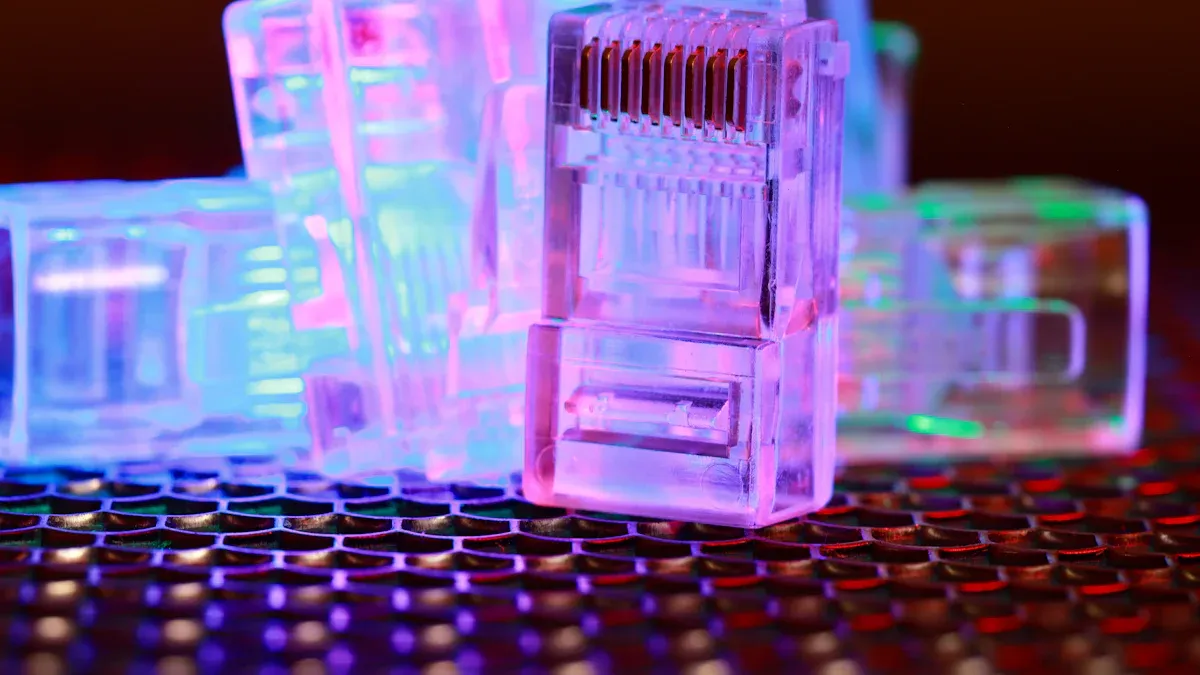
Definition
An LED plate is a flat panel that holds and supports LED lights. You will often see it as the main part of modern lighting fixtures. The plate spreads the light from each LED light source across a wide area. This design helps you get even and bright lighting in any room. The LED plate works with a guide to make sure the light covers the space without dark spots or glare. Many people choose LED plates because they use less energy and last longer than traditional lights.
Role in Lighting
You can think of the LED plate as the heart of your lighting system. It does more than just hold the lights. Here are some important ways it helps your lighting:
The LED plate helps manage heat, so your lights do not overheat. This keeps your lighting safe and makes it last longer.
It keeps each LED light in the right spot, which means you get even light across the room.
The plate gives strong support to the fixture, so your lights do not shake or move.
It helps save energy by working well with dimmers and other smart lighting controls.
The material and design of the plate affect how long your lights last and how good they look in your space.
When you use an LED plate with a good guide, you get better light quality and more control over your lighting.
Common Uses
You will find LED plates in many places because they work well in different settings. The table below shows where people use LED plates most often:
Setting | Frequent Applications of LED Panels |
|---|---|
Residential | Living rooms, kitchens, bathrooms, bedrooms, closets, laundry rooms |
Commercial | Office ceilings, retail stores, hotel lobbies, restaurants, hospitals, warehouses (high bays) |
LED plates give you bright, even light in homes and businesses. You can use them in kitchens for cooking, in offices for working, or in stores to show products. Many people like LED plates because they save energy, last a long time, and work with many types of lighting guides and controls. If you want reliable and flexible lighting, an LED plate is a smart choice.
Assessing Your Lighting Needs
Space and Size
Start by looking at the size of your space. The area you want to light will guide your choice of LED plate. Standard acrylic light guide plates come in sizes like 1220×2440mm, which fit most rooms. If you have a larger space, you can order custom plates up to 2000×3000mm. You can also adjust the thickness to match your lighting requirements. This flexibility helps you get the right amount of light for any room, from small offices to big halls. Always match the plate size to your room’s dimensions for the best results.
Brightness
You need to think about how bright you want your lights to be. The total light output depends on the room’s size and its use. Use the table below to find the recommended lumen output for different rooms:
Room Type | IES (lumens/sq ft) | ALA (lumens/sq ft) | Energy Star |
|---|---|---|---|
Living Room | 5-20 | 10-20 | N/A |
Bedroom | 5-15 | N/A | N/A |
Kitchen | 30-50 | N/A | N/A |
Bathroom | 15-30 | N/A | N/A |
Home Office | 30-50 | N/A | N/A |
To find the total lumens needed, measure your room’s square footage and multiply by the recommended value. For example, a 100 sq ft living room needing 20 lumens per sq ft will need 2,000 lumens.
Purpose
Think about what you will do in the space. Lighting requirements change based on the room’s purpose. If you plan to read, cook, or work, you need brighter lights. Theatrical spaces need special lighting and control systems. Sports areas must meet strict lighting requirements for safety. Pathways need steady light for comfort and security. Always match your lights and fixtures to the activities in the room.
Installation
Proper installation ensures your LED lights work well and last longer. Here are some tips:
Use insulation layers that transfer heat away from the LEDs.
Choose thicker copper traces to reduce heat.
Add thermal vias under the LED pads for better cooling.
Use thermal pads or sheets to remove air gaps.
Plan the layout to allow airflow and cooling.
Pick the right materials for your mounting plate.
Test the plate for stability before finishing the installation.
Follow safety rules and check your work after installing the lights.
Tip: Good installation helps your lights stay bright and safe for years.
Types of LED Plates
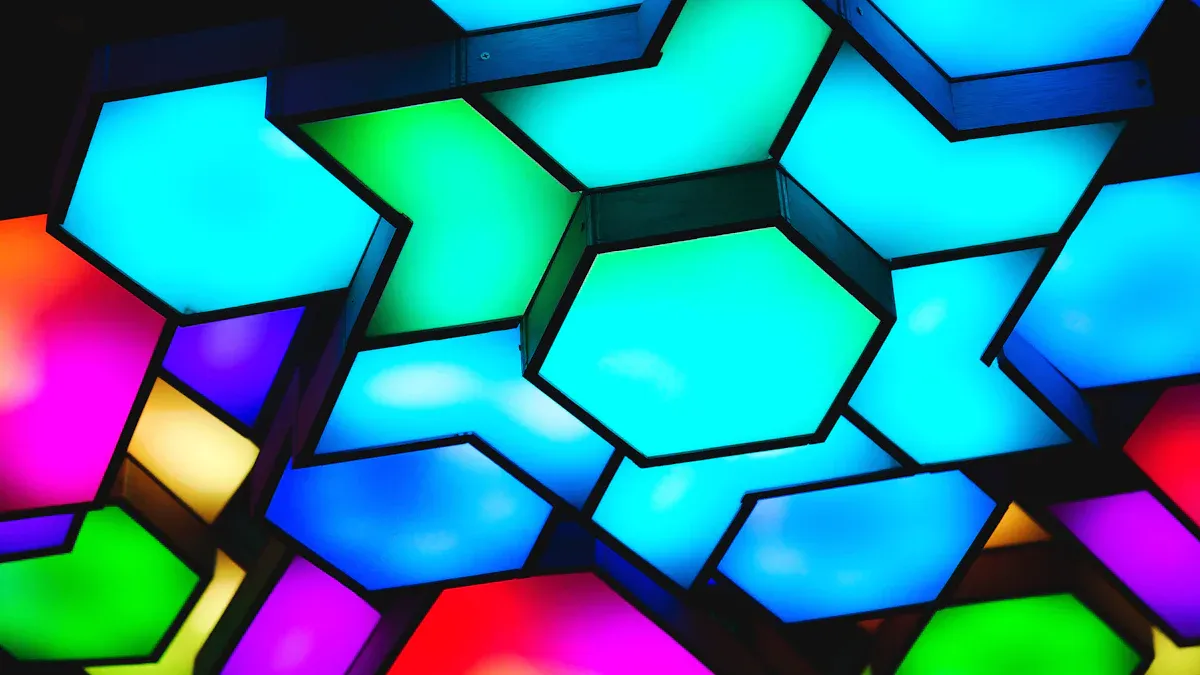
Materials
LED plates are usually made from glass or plastic. Each one is different and has its own uses. Acrylic is a kind of plastic. It is strong and light. You can carry acrylic plates more easily than glass ones. Acrylic is also easier to shape and decorate. Glass is heavier and can break more easily. The table below shows how strong and heavy each material is:
Material | Impact Strength (ft-lbs) | Weight (lbs/ft²) |
|---|---|---|
0.250" Plate Glass | 1.0 | 2.9 |
0.250" Tempered Glass | 15.5 - 29.1 | 2.9 |
0.250" Acrylic Sheet | 18.1 | 1.5 |
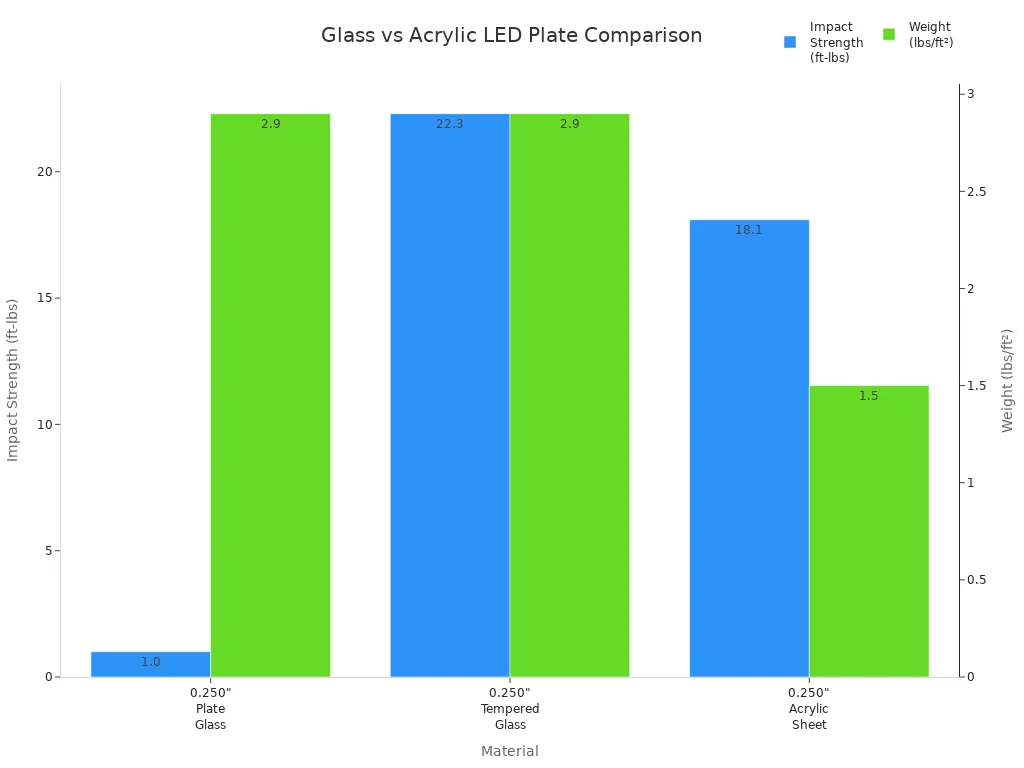
Polycarbonate is another plastic. It can last longer if you use pulse width modulation. This helps stop yellowing and keeps the plate clear.
Light Guide Plates
Light guide plates are important in edge-lit LED panel lights. You see them in many thin and bright panels. The light guide plate keeps light inside and spreads it out. Special patterns on the plate help scatter the light. This stops bright spots near the LEDs. You get a smooth and even glow. Light guide plates help make slim lights for offices, schools, and displays. These panels also work with diffusers and reflective films. This makes them brighter and saves more light.
Features
Modern LED panel lights have many cool features. Some let you dim the lights to change how bright they are. Advanced dimming protocols like 0-10V and DALI-2 work with smart controls. Some panels let you change the color temperature. This helps you set the mood in your room. Motion and daylight sensors help save energy by changing the light for you. Waterproof LED plates are good for outside or on boats. Some have high CRI for places where colors must look right. These features make LED panel lights useful for many projects.
LED Specifications
Lumen Output
Lumen output tells you how much light an LED plate produces. Higher lumens mean brighter light. You should focus on lumens, not just wattage, when you want to choose the right panel for your space. The amount of light you need depends on the size of the room, the color of the walls, and where you place the panel. For example:
A kitchen or workspace needs more lumens (300-500 lumens per square meter) for tasks.
Living rooms and bedrooms feel better with lower lumens (100-200 lumens per square meter) for a cozy mood.
Dark walls absorb more light, so you may need a higher lumen output.
Light-colored surfaces reflect more light, making the room seem brighter.
Color temperature and CRI also change how you see brightness. Always match the lumen output to the room’s function and style. This helps you get the right brightness and comfort.
Wattage
Wattage measures how much electrical power your LED plate uses. Lower wattage means less energy use. LED panels use much less power than old bulbs. For example, a typical LED bulb uses about 10 watts, but an old incandescent bulb uses 60 watts for the same amount of light. This saves about 75% of energy. You should look at wattage to estimate how much energy your panel will use and how much it will cost to run. Always check that your LED driver matches the wattage of your panel. This keeps your lighting safe and efficient.
Beam Angle
Beam angle shows how wide the light spreads from your LED plate. The right beam angle helps you control the look and feel of your room.
Narrow beam angles (10°–25°) focus light on small areas. Use these for task lighting or to highlight art.
Medium beam angles (30°–60°) balance focus and coverage. These work well for general lighting in most rooms.
Wide beam angles (90°+) spread light over large areas. These are best for ambient lighting in big spaces.
If you use a narrow beam, you get bright, focused light. A wide beam gives you soft, even light. You can mix different beam angles in one room to get the best effect. Always space your panels based on the beam angle to avoid dark spots or glare.
Color Temperature
Color temperature tells you if the light looks warm or cool. It is measured in Kelvin (K). The right color temperature changes the mood and function of your space. Use the table below to pick the best color temperature for your room:
Space Type | Recommended Color Temperature (Kelvin) | Atmosphere / Use Case |
|---|---|---|
Restaurants | Warm, cozy, relaxing | |
Hotels (lobbies, hallways) | 1800 K - 3000 K | Welcoming, comfortable |
Hotels (guest rooms) | 2700 K - 3000 K | Relaxing, restful |
Offices | 3000 K - 4000 K | Focus, productivity |
Hospitals | 3500 K - 5000 K | Alertness, clear visibility |
Schools & Universities | 2700 K - 5000 K | Warm for dining, cool for classrooms |
Outdoor sites, parking | 3000 K - 5000 K | Security, visibility |
General retail stores | 2700 K - 4000 K | Brand mood, product display |
Choose a warm color temperature for relaxing spaces. Pick a cool color temperature for work or study areas. Always check that your LED driver supports the color temperature you want.
CRI
CRI, or Color Rendering Index, shows how well your LED plate makes colors look natural. A high CRI means colors look true and clear. CRI uses eight test colors to measure quality, but LED lights sometimes have gaps in their color spectrum. This means a high CRI does not always guarantee perfect color. Some LED panels with lower CRI can still look good in real life. Newer tests like the Fidelity Index (Rf) and Gamut Index (Rg) give more detail, but CRI is still the most common rating. For most rooms, a CRI above 80 works well. For art studios or stores, you may want a CRI above 90. Always check that your LED driver and panel work together to keep color quality high.
Lifespan
LED plates last much longer than old lighting types. Most LED panels work for 50,000 to 100,000 hours. This means you do not need to replace them often. You save time and money on maintenance. The table below shows how LED plates compare to other lights:
Lighting Type | Average Lifespan (hours) | Relative Lifespan Compared to LED |
|---|---|---|
LED Plates | Baseline | |
Fluorescent, Metal Halide, Sodium Vapor | ~12,500 - 50,000 | 2 to 4 times shorter |
Incandescent Bulbs | ~1,250 | More than 40 times shorter |
A good LED driver helps your panel last longer by giving steady power and protecting against surges.
Energy Efficiency
LED panels stand out for their high efficiency. They use less power to make the same amount of light as other bulbs. This means you save money and help the environment. A University of Michigan study found that LED lighting is up to 44% more energy efficient than fluorescent tubes. LEDs also last longer and do not have harmful materials like mercury.
Brightness (Lumens) | Incandescent Watts | CFL Watts | |
|---|---|---|---|
400 – 500 | 40W | 8 – 12W | 6 – 7W |
650 – 850 | 60W | 13 – 18W | 7 – 10W |
1000 – 1400 | 75W | 18 – 22W | 12 – 13W |
1450 – 1700+ | 100W | 23 – 30W | 14 – 20W |
2700+ | 150W | 30 – 55W | 25 – 28W |
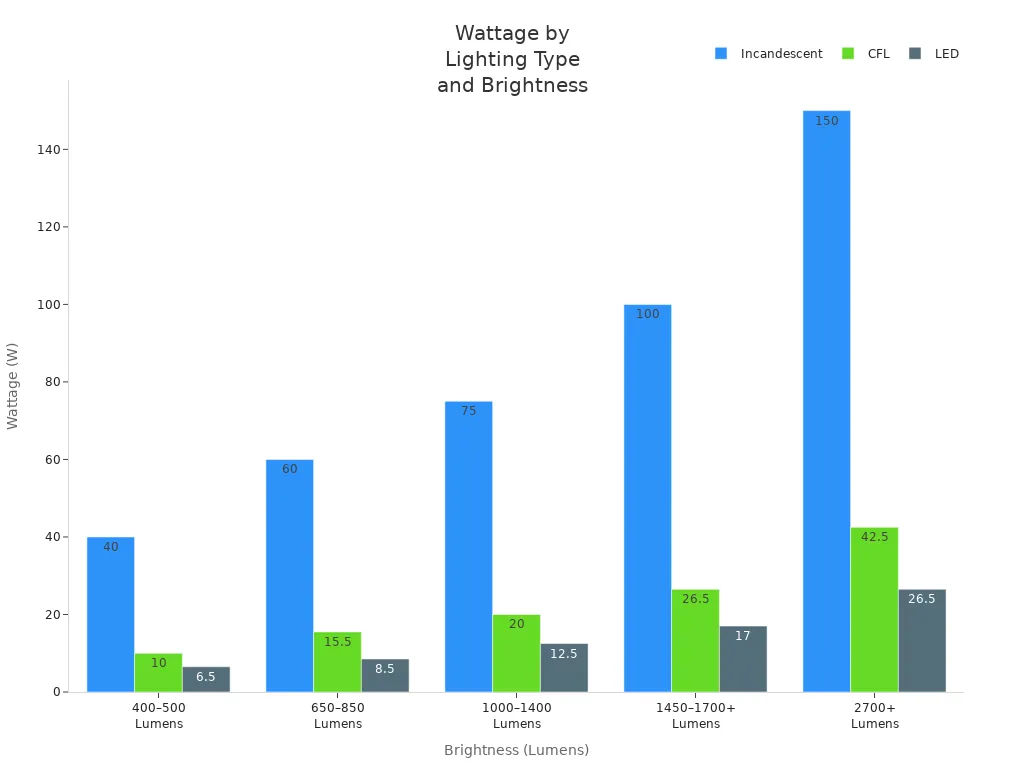
LED panels also have lower total costs over time. You buy fewer bulbs and pay less for electricity. Always use a high efficiency LED driver to get the best energy saving results. This boosts energy efficiency and keeps your lighting system running smoothly.
Tip: Choose LED panels with a high efficiency LED driver for the best energy efficiency and long-term savings.
LED Panel Lights
Mounting Options
You can choose from several mounting options when you install LED panel lights. Each method fits different spaces and needs. The most common way is recessed mounting. You place the recessed LED panel light into the ceiling, so it blends with the building. This style works well in offices and modern homes. If you have a cement ceiling or cannot drill holes, you can use a surface-mounted LED panel light. This type uses extra frames or a special lamp body to attach the panel directly to the ceiling. It is a good choice for spaces where you want easy installation and access. Suspension mounting lets you hang the panel lights from the ceiling with wire ropes. This method gives a stylish look and works well in rooms with high ceilings or open designs.
When you pick a mounting option, think about the installation steps. Some types of LED panel lights need drilling, while others use clips, brackets, or steel ropes. Always check if your ceiling supports the weight and size of the panel. The best LED panel lights offer flexible mounting choices, so you can match your space and style.
Controls and Sensors
Modern LED panel lights come with smart controls and sensors that make your lighting system more efficient. You can find motion radar sensors that turn the lights on when someone enters the room. Light sensors adjust the brightness based on how much daylight is present. These features help you save energy and keep your space comfortable.
Some types of LED panel lights let you change the power settings or pick different color temperatures. You can set the mood or match the activity in the room. Many best LED panel lights combine motion and light sensors for even better control. Advanced systems use timers, temperature sensors, and wireless modules like Bluetooth. You can manage your lights remotely or set them to adjust automatically. These smart features make LED panel lights a top choice for homes, offices, and schools.
Tip: Choose LED panel lights with built-in sensors and controls for the best energy savings and comfort.
Quality and Reliability
Brand
When you pick a lighting brand, always check if it is trusted. Good brands usually make better and more reliable products. Look for brands with good reviews and a strong history. These brands test their products for heat, electricity, and light quality. They check things like junction temperature and thermal resistance. They also measure how well the panel changes energy into light. These tests help make sure the panel works well for a long time. Brands that have DOT or ECE certifications follow safety rules. You can also see if the brand offers extra features, like automatic settings or built-in heating. These features show the brand cares about quality and making products last.
Warranty
A good warranty helps you feel safe about your purchase. Most lighting warranties last 3 to 5 years. Some brands, such as Litetronics, give up to 10 years or 100,000 hours of coverage. Warranties cover problems with materials or how the panel was made. You must install and use the panel the right way. Labor costs are not part of the warranty. If you use the wrong driver or install it wrong, the warranty will not work. The table below shows how long warranties last and what they cover for different products:
Product Category | Warranty Duration | Coverage Details | Exclusions and Conditions |
|---|---|---|---|
Grote Economy sealed lamps | 1 year | Limited warranty | N/A |
Grote LED lamps (Special LED Limited Warranty) | 1 to 10 years (varies) | Covers defects in workmanship and materials | Must remain intact, free from physical abuse, proper installation, use only with approved wiring accessories |
Grote SuperNova® high performance LED lamps | 10 years (with approved connectors) | Replacement if defective during warranty period | Voided by physical abuse, chemical damage, improper installation |
Grote SuperNova® (hardwire bullet connectors) | 3 years | Limited warranty | Same as above |
Grote MicroNova® high performance LED lamps | 3 years | Limited warranty | Same as above |
Grote Hi Count® LED lamps | 2 years | Limited warranty | Same as above |
Grote WhiteLight™ LED lamps | 3 years | Limited warranty | Same as above |
Grote Select™ LED Stop/Tail/Turn and Backup lamps | 2 years | Limited warranty | Same as above |
Grote Select™ LED Flood Lamps | 1 year | Limited warranty | Same as above |
Grote Warning & Hazard LEDs | 2 years | Limited warranty | Same as above |
Other Grote LED lamps (non-FMVSS) | 1 year | Limited warranty | Same as above |
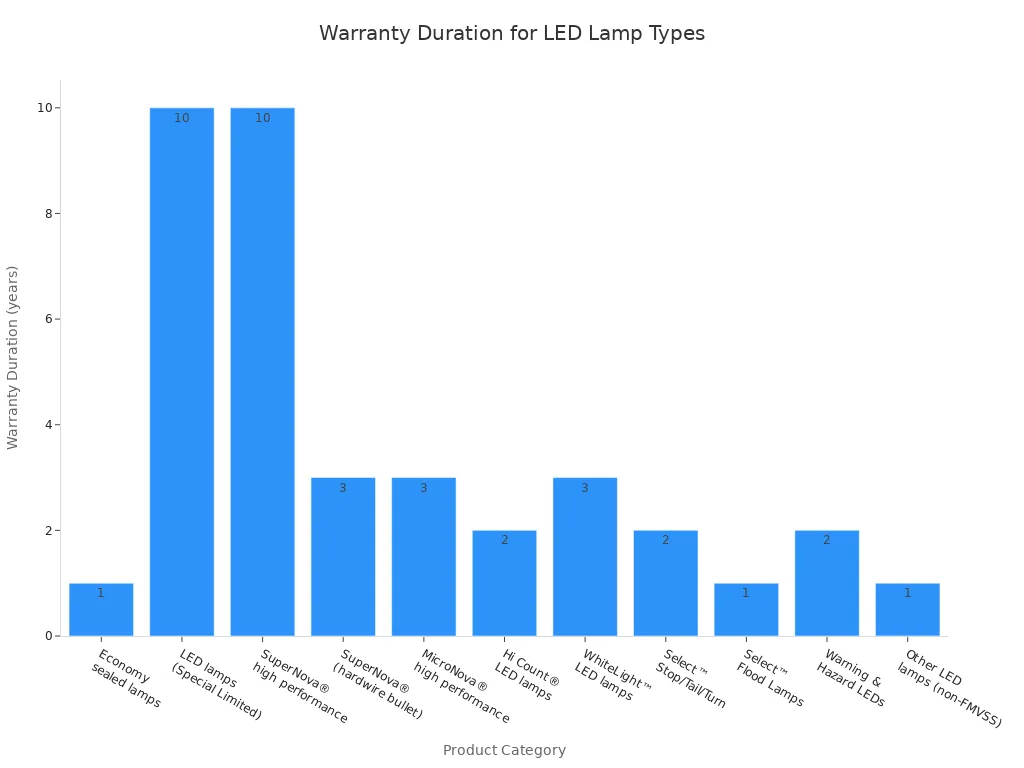
Note: Always read the warranty rules. Use the right driver and follow the instructions to keep your warranty.
Common Issues
You might have some problems with lighting panels. Flickering, buzzing, or getting too hot can happen if you use the wrong driver or bad wiring. Loose wires or bad installation can make the lights fail or lose power. You can stop most problems by doing these things:
Clean the panel lens with a soft cloth and soap.
Check for cracks to keep water out.
Look at all wires for rust or loose spots.
Use the right driver with the correct voltage and wattage.
Change blown fuses or broken power supplies.
Check wire direction with a multimeter.
Dry the panel after cleaning to stop water problems.
Common Issues with LED Plates and Lighting | Prevention Methods |
|---|---|
Flickering lights | Ensure proper wiring and secure connections |
Buzzing/humming noises | Use correct wattage and compatible drivers; secure wiring |
Overheating | Provide adequate heat sinks and ventilation |
Poor wiring and loose connections | Check and tighten all wiring connections during installation |
Incorrect installation | Follow correct installation procedures; verify wiring polarity |
Voltage drops | Use high-quality cabling and assess load needs before installation |
Wrong LED drivers | Use drivers with correct voltage and wattage ratings |
Dim or excessively bright lights | Use appropriate LED brightness and consider dimming options |
UV and IR emissions | Select LEDs with minimal UV/IR output if relevant |
Blue light pollution | Choose LEDs with suitable color temperature |
Regular maintenance | Clean, inspect, and troubleshoot regularly to extend lifespan |
You can keep your lights working well by using the right driver, following the steps, and checking them often. This helps your lighting stay good and reliable for many years.
Choosing the Right LED Plate
Project Scenarios
You face many choices when you start a new lighting project. Choosing the right led plate depends on where you want to use it. Each space has its own needs. Let’s look at some common scenarios to help you make the best decision.
Residential Lighting
You want your home to feel warm and comfortable. The best led panel lights for living rooms and bedrooms often have a soft color temperature. These panels spread light evenly, so you avoid harsh shadows. In kitchens, you need brighter led panel lights for cooking and cleaning. Bathrooms need led panel lights that resist moisture. When you choose a ceiling panel light for your home, check if it fits your ceiling type and matches your style.
Commercial Lighting
Offices, stores, and schools need strong and reliable lighting. The best led panel lights for these spaces give bright, even light that helps people work and learn. You can use led panel lights with smart controls to save energy. In retail stores, you want led panel lights that show products in their true colors. Warehouses need led panel lights with high efficiency and long lifespan. When you choose a ceiling panel light for a business, look for panels that are easy to install and maintain.
Specialty Uses
Some places need special lighting. Hospitals need led panel lights that are easy to clean and do not flicker. Art studios and galleries use led panel lights with high color accuracy. Outdoor spaces or wet areas need waterproof led panel lights. If you have a boat or RV, you want led panel lights that use little power and last a long time. Always use a guide to match the panel features to your unique needs.
Tip: Think about how you use each space. The right guide helps you find the best led panel lights for every project.
Buying Tips
Choosing the right led plate is easier when you follow a clear guide. Use these tips to make a smart choice and avoid common mistakes:
Work with a trusted lighting sales professional. They know the best led panel lights and can answer your questions.
Not all led panel lights are the same. Avoid sellers who offer cheap, low-quality products.
Ask about the led panel light benefits, such as energy savings, long lifespan, and low maintenance.
Check if the panel offers rebates or tax deductions. These can lower your total cost.
Think about your main reasons for switching to led panel lights. You may want better light, lower energy bills, or less time spent on repairs.
Start your search early. This gives you more time to compare options and avoid paying too much.
Use a guide or checklist to keep track of your needs and questions.
Make sure you understand the warranty and what it covers.
Ask about installation. Some led panel lights are easier to install than others.
Choose led panel lights that match your ceiling and room size.
Here is a simple checklist to guide your final decision:
Checklist Item | Why It Matters |
|---|---|
Trusted seller or lighting professional | Ensures quality and support |
Product quality and brand reputation | Reduces risk of early failure |
Energy efficiency and led panel light benefits | Saves money and energy |
Warranty coverage and terms | Protects your investment |
Installation requirements and support | Makes setup easier |
Cost, rebates, and tax incentives | Lowers your total cost |
Panel size, brightness, and color temperature | Matches your space and needs |
Smart controls and features | Adds comfort and saves energy |
Maintenance and cleaning needs | Keeps lighting working longer |
Guide or checklist used before purchase | Helps you make the best choice |
Note: Making an informed choice now helps you avoid problems later. Many people regret their purchase within two years if they skip these steps.
Choosing the right led plate gives you better lighting, lower cost, and more comfort. Use a guide, ask questions, and compare the best led panel lights before you buy. You will enjoy the led panel light benefits for years to come.
To choose the right LED plate, follow these steps:
Measure your space and ceiling height.
Calculate the brightness you need for each room.
Match the panel’s features to the room’s purpose.
Select the best installation method.
Pick a panel type that fits your needs.
Before you buy, use the checklist to compare options. You can also review product catalogs, specification sheets, and design guides. If you need help, consult a professional or explore support services. The right choice gives you even light, energy savings, and a modern look.
FAQ
What is the difference between an LED plate and an LED panel light?
You use an LED plate as the main light-spreading part inside a fixture. An LED panel light is the complete product, including the plate, frame, driver, and cover. The plate helps spread light evenly.
Can you install LED plates by yourself?
You can install many LED plates with basic tools. Always follow the instructions. If you feel unsure, ask a professional for help. Safety comes first.
How do you clean and maintain LED plates?
Use a soft cloth and mild soap to wipe the surface. Avoid harsh chemicals. Check for dust or cracks often. Clean panels help keep your lights bright and working well.
Do LED plates work with dimmer switches?
Some LED plates work with dimmers. Check the product label or ask the seller. Use only compatible dimmers to prevent flickering or buzzing.
How long do LED plates usually last?
Most LED plates last 50,000 to 100,000 hours. You can expect many years of use. Good care and the right driver help them last longer.
See Also
Selecting The Ideal Wall Mount For Your LED Light Box
Finding The Best LED Display Sign For Your Business
Choosing The Optimal LED Digital Sign To Meet Business Needs
Picking The Best Acrylic LED Board For Effective Business Signage
Selecting Premium Acrylic Panels For Your Light Box Display Projects

